Here is my data [![enter image description here][1]][1] my code
library(ggplot2)
library(reshape)
dt1 =read.csv("C:/Users/My DELL/Documents/R_data/machine learning/dt1.csv")
head(dt1)
dt1$month <- seq(nrow(dt1))
library(reshape2)
mm <- melt(subset(dt1,select=c(month,EgbeNa,UrejeNa,EroNa,RefNa,EgbeMg,UrejeMg,EroMg,RefMg
)),id.var="month")
head(mm)
library(lattice)
xyplot(value ~ month|variable,data=mm,type="l",
scales=list(y=list(relation="free")),
layout=c(1,8))
dt_repr = structure(list(Date = c("01-11-17", "01-12-17", "01-01-18", "01-02-18",
"01-03-18", "01-04-18", "01-05-18", "01-06-18", "01-07-18", "01-08-18",
"01-09-18", "01-10-18", "01-11-18", "01-12-18", "01-01-19", "01-02-19",
"01-03-19", "01-04-19", "01-05-19", "01-06-19", "01-07-19", "01-08-19",
"01-09-19", "01-10-19"), month = 1:24, EgbeNa = c(27.4, 29.25,
31.1, 20.4, 13.55, 14, 16.25, 18.5, 24.95, 16.2, 30.15, 28.6,
35.1, 36.5, 28.45, 31.5, 38.1, 28, 32.55, 30.5, 33.2, 30.8, 13,
24.3), UrejeNa = c(10.45, 9, 7.55, 13.35, 11.6, 12.475, 20.1625,
27.85, 21.5, 32.05, 17.65, 15.15, 25.7, 18.8, 26.85, 20.65, 23.5,
26.45, 30.2, 25.75, 28.3, 31.45, 44.4, 39.6), EroNa = c(44.45,
40.55, 36.65, 43, 39.825, 36.825, 44.1, 51.65, 44.2, 56.1, 61.3,
66.05, 15.75, 19.15, 13.05, 12.2, 21.7, 17.9, 14.6, 33.3, 21.2,
19.6, 32.7, 25.1), RefNa = c(10.55, 9.75, 12.35, 19.65, 10.6,
13.74, 22.62, 25.82, 20.4, 31.2, 16.95, 14.25, 15.03, 17.15,
12.75, 13.5, 20.45, 16.8, 15.5, 25.4, 19.5, 19.8, 26.7, 25.1),
EgbeMg = c(4.118, 4.7155, 5.313, 4.4865, 5.1535, 5.1295,
5.113, 5.103, 5.721, 5.285, 3.8575, 4.128, 5.4205, 6.2975,
5.134, 5.4605, 5.124, 4.203, 5.2635, 5.135, 6.092, 5.575,
4.139, 4.8645), UrejeMg = c(3.6655, 3.977, 4.288, 4.192,
4.676, 4.434, 4.7005, 4.966, 5.3895, 5.7165, 4.881, 4.1015,
3.743, 6.132, 6.0785, 6.1775, 6.3135, 6.028, 5.739, 6.126,
4.5155, 4.716, 5.2165, 5.678), EroMg = c(2.472, 2.31425,
2.1565, 2.2115, 2.184, 2.135, 4.135, 6.2005, 5.457, 5.981,
5.784, 5.885, 5.406, 5.248, 4.967, 4.449, 5.058, 5.1675,
5.667, 6.966, 5.17, 4.8965, 7.201, 6.538), RefMg = c(3.75,
3.87, 4.82, 4.132, 3.98, 4.23, 4.57, 5.01, 5.02, 4.67, 4.18,
4.51, 5.21, 5.18, 4.76, 4.29, 4.95, 5.07, 5.45, 5.86, 5.11,
4.79, 6.01, 5.24)), class = "data.frame", row.names = c(NA,
-24L)) #This data is reproducible
I want to use Date as my x-axis, the Date covers 24 months. It starts at 01-11-17 and ends at 01-10-19. Anyone can help please.

